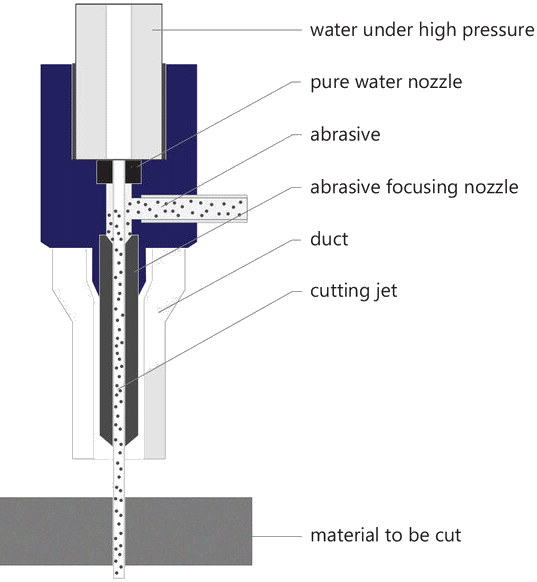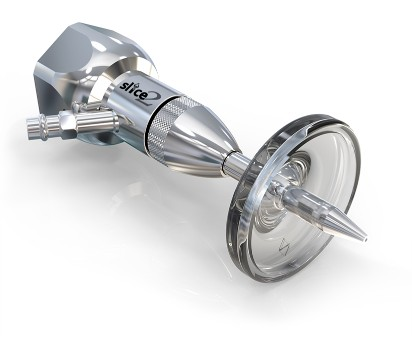Water Jet Cutting
Waterjet cutting technology has been harnessing the power of water since the beginning of the 20th century: first for digging gravel and clay, then in the 1930s for mining ore and coal using a high-pressure waterjet.
In the 1960s, the aircraft manufacturer Boeing finally took the decisive step of using the waterjet as a cutting technique. In 1971, the first machine for waterjet cutting was finally manufactured.
At that time, pressure intensifiers were mainly used, which generated the cutting jet in their high-pressure cylinders. Later, piston pumps were also used, which generated the jet by means of direct drive.
The start was made with so-called pure water cutting; thus, the first industrial application was the cutting of disposable diapers. At the same time, research was carried out into using various additives to cut metals and composite materials as well. The addition of abrasive was the breakthrough for the waterjet cutting process. The following decades saw double-digit annual growth rates in machine sales.

But let's take a closer look at today's process.. A high-pressure pump ensures that the water jet in a modern cutting machine is compressed to up to 6,000 bar and then forced through a nozzle. As a result, the jet reaches exit velocities of up to 1,200 m/s. This corresponds to about four times the speed of sound. This is roughly equivalent to four times the speed of sound. This jet velocity and the addition of abrasive creates the cutting jet for material removal.
In industry and cutting operations, pressures of 4,000 bar have become established as the ideal compromise between performance and durability. Today, manufacturers are continuously working on concepts to save water and energy. In this context, each waterjet cutting system is in itself a contribution to environmentally friendly, modern manufacturing.
Since only natural materials such as water and sand are used in this cutting technology, neither toxic gases nor vapors are produced. The waste from machining, the dirty water and the broken grains of sand are not critical for the environment and can be fed into the recycling system.
With pure water or additional abrasives
Two variants of waterjet technology are predominantly used in industry.. pure waterjet cutting or abrasive cutting. Micro waterjet cutting and suspension waterjet cutting are technologies that also use abrasive waterjet; in panel cutting, these two technologies play only a minor role.
Pure water cutting
Pure waterjet cutting is used for soft materials. With a diameter of a few tenths of a millimeter, the pure waterjet penetrates the material as if with a knife. In contrast to abrasive waterjet cutting, no material is ground out of the kerf here, but only a fine cut is produced.
Pure water cutting is used for cutting seals, rubber, leather, fabric and thin plastics. Metals, on the other hand, can only be cut with it in the form of extremely thin foils.
Clean water cutting usually requires a very fast machine, as the cutting speeds are much higher than for abrasive cutting. For the typical materials that are cut with pure water, additional material supports are also required to support the thin and soft material during cutting. Here, honeycombs made of aluminum, stainless steel or polypropylene have proven to be a very good solution.
When purchasing a waterjet cutting machine, the possibilities of clean water cutting should be included in the decision. Not all machines are suitable for this cutting process due to their design and the speeds that can be achieved. With pure water cutting, the abrasive medium can be dispensed with. The cutting head is modified accordingly so that the focusing tube can be dispensed with and the nozzle is the final element.
Clean water applications require less water volume and often lower cutting pressure. A machine in which these possibilities have already been taken into account in the design can more than halve operating costs for pure water cuts.
Abrasive cutting
Abrasive cutting is the most widely used process in the field of waterjet cutting. The nozzle diameter, the pressure and the cutting medium influence the achievable jet power. As with pure water cutting, the water jet from the high-pressure pump is forced through a sapphire, ruby or diamond nozzle at pressures of up to 6,000 bar. However, this jet does not hit the workpiece directly, but is mixed with an abrasive in a ceramic mixing chamber.
The abrasive is sucked into this cutting head via the Venturi effect and emerges - mixed with the water - from a focusing tube. This focusing tube is made of extremely hard and wear-resistant tungsten carbide. Nevertheless, even this focusing tube is washed out after a certain time by the abrasive jet. For modern cutting heads, these focusing tubes are available in different diameters, lengths and qualities, so that the user can choose the most economical solution for himself.
There are also cutting heads on the market in which the two wear components, nozzle and mixing chamber, are permanently installed. These heads are more expensive to operate because they have to be completely replaced as soon as one of the components is worn out.
The abrasive used is usually garnet sand or a similar hard, ground rock. The abrasive is also available in different qualities and grit sizes. The 80 mesh grit has become the standard in the industry. This grit is currently the best compromise in terms of cutting performance and surface quality.
For applications in the glass or plastics sector, 120 mesh is also often used to improve the surface quality and thus produce silky-smooth cutting surfaces. In micro waterjet cutting (microcutting / microwaterjet), grit sizes of 300-400 mesh are even used. This abrasive material produces optimum quality during cutting and reduces surface roughness; however, it is very expensive.
In individual cases, other abrasives such as salts, quartz or garnet/corundum mixtures can also be used. In this case, however, a number of points must be taken into account. In order to carry out special applications in the best possible way, expert advice from experienced waterjet technicians is recommended.
WATERJET CUTTING HEAD
Image.. www.dtiinside.com

FAQ
WHAT IS WATERJET CUTTING AND WHAT ARE THE ADVANTAGES OF THIS TECHNOLOGY?
- Waterjet cutting is a cold-cutting process. This has the advantage that no structural change occurs at the cutting line during cutting. A hardened steel plate can be cut without the cutting edge losing its hardness. Any material can be cut with the waterjet and the machine does not have to be retooled to cut steel, plastic or glass alternately.
HOW THICK CAN THE MATERIAL BE FOR WATERJET CUTTING?
- You can basically cut material thicknesses up to 500 mm. However, the thicker the material, the longer the cutting time. It makes sense to cut steel up to about 80 mm and aluminum up to about 120 mm, granite up to 100 mm and ceramics up to about 30 mm.
IS WELD SEAM PREPARATION POSSIBLE WITH A WATERJET CUTTING SYSTEM?
- Yes, all common types of weld seam preparation are possible with a waterjet cutting machine, provided the machine is equipped with a 3D head.
WHAT ARE THE ADVANTAGES OF WATERJET CUTTING OVER PLASMA / OXYFUEL FLAME CUTTING?
- Plasma and flame cutting is limited to a few metals. Waterjet cutting works with almost any material. The surface is slightly rough, but because there is no heat input, there is no discoloration on the cut edge and the contour accuracy is much better.
WHY SHOULD I USE WATERJET CUTTING INSTEAD OF LASER TECHNOLOGY?
- Unlike laser cutting, waterjet cutting is not tied to specific materials, but can be used universally. In steel, stainless steel and aluminum, waterjet cutting is more economical than the laser above a certain material thickness. With the abrasive waterjet, thin sheets can be cut in a package. This is not possible with the laser.
WHAT ACCURACIES CAN BE PRODUCED WITH WATERJET CUTTING AND WHAT DOES THE CUT SURFACE LOOK LIKE?
- Depending on the equipment of the machine, the achievable accuracies are in the low tenth range up to the range of a few hundredths of a millimeter. The surface is slightly rough to silk-matt, depending on the speed and grain size of the abrasives. There is no discoloration at the cut edge as with thermal cutting processes.
Reference(s) .. microstep.com
Related Post(s)

The most common on-site machining services are flange face machining, line boring, milling, drilling, and pipe cutting...